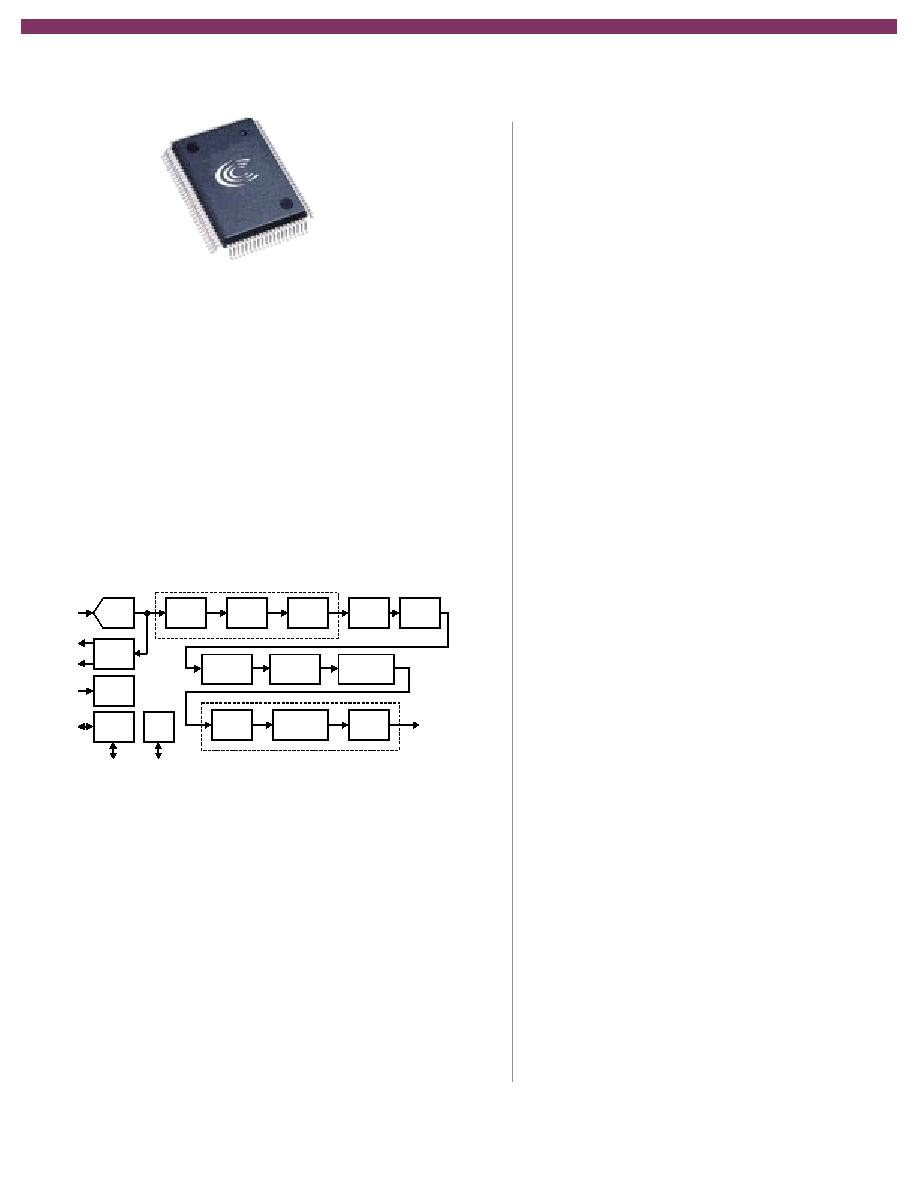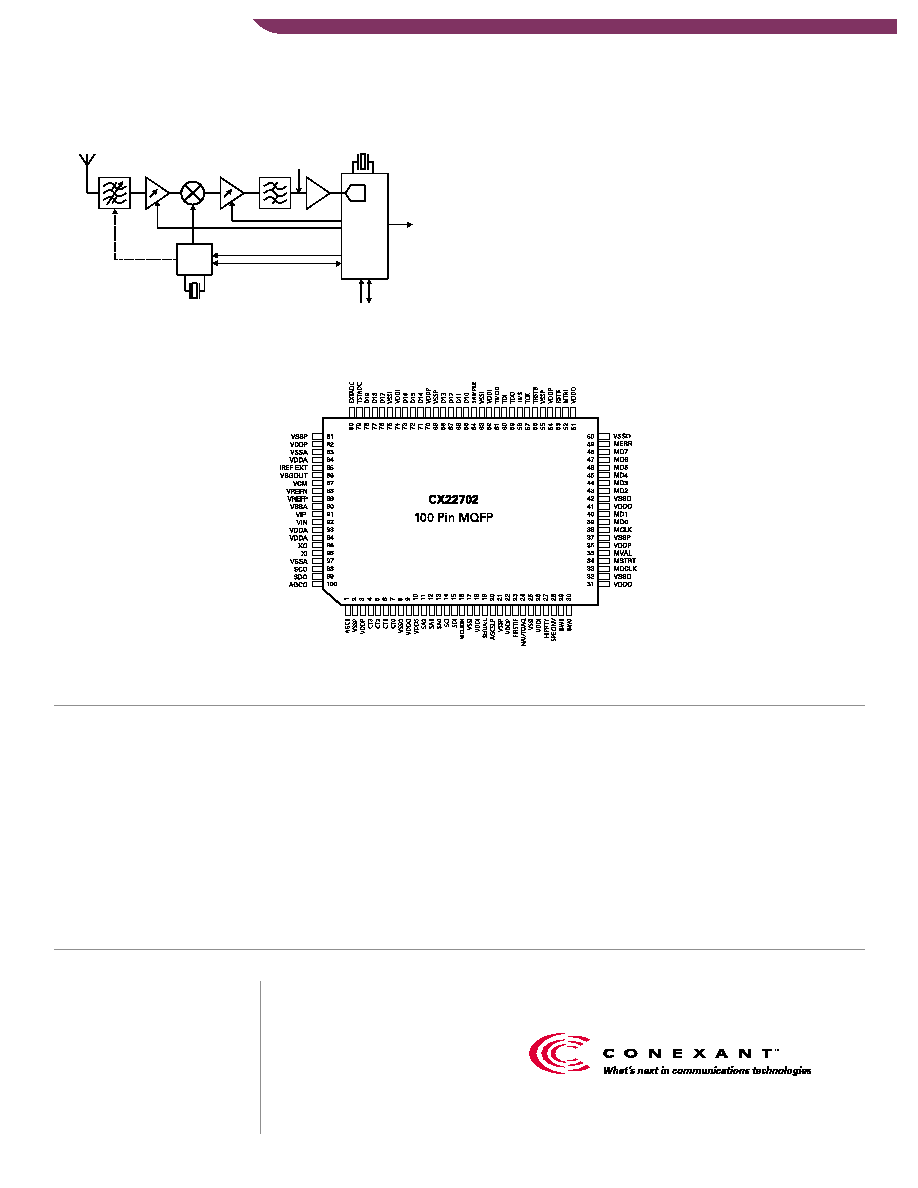
· Implements entire DVB-T standard
· Optimal performance in an
SFN environment
· Excellent AWGN performance < 18.0db
(64 QAM, 2/3 code rate)
· Active impulse noise filtering
· Operation using single SAW filter in
the IF path
d i g i t a l i n f o t a i n m e n t p r o d u c t s
Single
-
Chip Solution
for DVB
-
T Systems
C X 2 2 7 0 2
Conexant's CX22702 is a single-chip coded orthogonal frequency
division multiplex (COFDM) demodulator/decoder solution for
both 2K and 8K digital video broadcast-terrestrial (DVB-T) systems.
Providing exceptional echo performance, the device is ideally
suited to receiving the broadcast signal in countries deploying
single frequency network (SFN) implementations of the DVB-T
system. The cost-effective CX22702 also offers a high level of
integration, along with the ability to sample the incoming signal
at a high or low intermediate frequency (IF).
Along with COFDM demodulators, Conexant also offers interactive
TV decoder products -- the CX2249x family -- to provide low-cost
solutions for the core electronics of platforms deployed in digital
terrestrial TV networks. A system solution for a high-end set-top
box with integrated hard disk drive (HDD) is shown below
in Figure 1.
D i s t i n g u i s h i n g F e a t u r e s
Tuner
CX22702
CX22492
SDRAM
Flash
Modem
HDD
RJ-11
C/RGB
Stereo
DAC
L
R
CX22702
Tuner
Figure 1. CX22702/CX22492-based set-top box system.

d i g i t a l i n f o t a i n m e n t p r o d u c t s
Single
-
Chip Solution
for DVB
-
T Systems
C X 2 2 7 0 2
Input Signal
The CX22702 can accept an input signal centered at
a high IF of either approximately 36.167 MHz (typical
for 7 MHz or 8 MHz channels) or 44.1 MHz (for a 6
MHz channel). Alternatively, the input signal could be
at a low IF of approximately 4.57 MHz. The input is an
analog signal, which is sampled using the internal 10-
bit analog-to-digital converter (ADC). The device can
meet European requirements for adjacent-channel
performance with a single SAW filter. The CX22702
uses digital filters to remove adjacent channel signals
(e.g., NICAM). The tuner's automatic gain control
(AGC) is controlled via a single or dual sigma-delta
feedback. Only a simple RC filter is required to
generate the analog control voltage.
From IF Input to MPEG Output
The CX22702 performs all the functions required to
produce an MPEG transport stream output from the
IF input. First, it detects impulse interference by
performing a proprietary analysis of the OFDM
waveform and a detector in the AGC. Then the time
domain adapter enables the chip to address 6, 7,
and 8 MHz bandwidth channels as well as adapt to
different IFs, sample timing and frequency offsets. In
addition, the time domain adapter removes adjacent
channel interference and removes the cyclic prefix
prior to the fast fourier transform (FFT). During
channel acquisition, the time domain adapter uses
a set of algorithms that allow frequency, sample
timing, and guard interval lock to be achieved quickly
and reliably before switching to a different set of
algorithms, which provide good tracking
performance. For optimal performance in an
SFN, the position of the FFT window is dynamically
located to the strongest signal present in the
guard interval.
After the FFT, a common phase-error correction is
applied prior to channel estimation and correction.
Scattered and continual pilot carriers are used to
correct channel distortion, fading and phase noise
within the carrier bandwidth. The channel estimate
also provides Channel State Information (CSI), which
passes on to the Viterbi decoder, where it improves
performance by identifying bits from data carriers
that have undergone severe fading. Additional
proprietary error-correction techniques improve
further upon the performance. CSI can also mask
bits from data carriers that are particularly affected
by co-channel analog interference (e.g., PAL/SECAM).
The CX22702 uses proprietary memory-efficient
algorithms to produce the channel estimate.
By default, the CX22702 initially determines all
transmission parameters (including 2K/8K
transmission mode and guard interval) from the
received signal. These parameters are stored and
used to reduce the time needed for subsequent
channel acquisitions.

The CX22702 can interface directly to all Conexant TV
decoder devices and other commonly available MPEG transport
demultiplexer chips, as well as directly to a DVB common
interface. The data rate is smoothed to remove gaps introduced
by the COFDM guard interval and variation in processing time
within the forward-error correction (FEC) circuitry. This allows
a stable clock reference to be extracted from the transport
stream more quickly, further reducing the overall time before
the viewer sees a picture.
Applications
Figures 3 shows a possible application of the CX22702 using a
conventional tuner architecture and first IF sampling, where an
input signal centered on 36.167 +/ 0.2 MHz is sampled directly.
This method greatly reduces the component count in the tuner,
allowing a mixer and oscillator to be replaced by an amplifier,
which provides the required input level for the ADC. Only one
SAW filter is required in this application.
What is COFDM?
Coded orthogonal frequency division multiplexing
(COFDM) is the method adopted by the Digital Video
Broadcasting (DVB) Group for digital terrestrial broadcast-
ing. (Here, "terrestrial" refers to land-based, as opposed to
satellite broadcasting). To understand what this acronym
means, let's break it down into its component parts.
Frequency division multiplexing (FDM) refers to the divi-
sion of a communications channel into different frequency
bands. This is a commonly used technique in analog TV
broadcasting, in which different TV stations broadcast on
different frequencies. But in analog TV, the carrier frequen-
cies are spaced 6 or 8 MHz apart; in DVB-T, there are 2,048
carriers (with "2K" mode) or 8,192 carriers (using "8K"
mode) in a given 6, 7 or 8 MHz band. Using conventional
techniques, carriers spaced this close together would
interfere with each other. But because the carriers are
"orthogonal", or non-overlapping, they do not. As a TV
signal travels between the transmitter and the receiver, it
may encounter interference from a variety of sources. In
addition, echoes occur as the signal is reflected from hills,
buildings, trees and moving objects. These echoes interfere
with the signal and cause it to fade. By coding the signal
using powerful error-correction techniques (the "coded" in
COFDM), data in carriers that have been destroyed by
interference can be recovered. Because of these capabilities,
COFDM has proven itself superior to other methods of
digital terrestrial broadcasting.
ADC
Resample
Guard
Detector
Window
Position
2K/8K
FFT
Common
Phase-Error
Correction
Trellis
Decoder
Forward Error Correction
Time Domain Adapter
IF
SD
SD
XTAL
Tuner
Forney
Deinterleaver
Reed
Solomon
Decoder
Channel
Estimator
and Corrector
Inner
Demapper and
Deinterleaver
MPEG
Transport
Stream
Pilot
Locate
AGC
PLL
Serial
Interface
JTAG
Figure 2. CX22702 functional block diagram.

f e a t u r e s a n d s p e c i f i c a t i o n s
· Implements complete DVB-T
(ETS 300 744) standard
· DTG, EACEM and NorDig compliant
· 2K and 8K transmission modes
· Optimized for SFN environments
· Dynamic FFT window positioning
· Active impulse noise filtering
· Input signal can be sampled at high
or low IF
· Meets European requirements using
single SAW filter
· AWGN performance <18.0dB
(64 QAM, 2/3 code rate)
· Excellent CCI PAL performance
· Differential or single-ended integrated
10-bit ADC
· Single or Dual
AGC feedback
to tuner
· Four GPIO/
DAC pins
· Internal digital AFC loop (no feedback
to tuner)
· Internal digital clock recovery loop
(fixed frequency input, no need
for VCXO)
· Channel estimation and correction
· Common phase-error correction
· Fast automatic channel-acquisition
time
· Maintains and uses channel state
information (CSI)
· Serial (I
2
C compatible) host interface
· Can achieve automatic lock from
initial frequency offsets of up
to 200 kHz
· 6, 7 and 8 MHz channel support
· Serial or parallel MPEG transport
stream output suitable for direct
connection to transport demux chips
(CX22490 TV decoder range)
· Minimal host software required
· JTAG boundary scan
· Low power consumption: < 1.0W
· 100-pin MQFP
Because many standard tuners have an IF output at
about 4.57 MHz (32/7 MHz), the CX22702 can also sample
a signal centered on this frequency. Selection is made
using either a pin on the device (first IF) or a register.
In both cases, adjacent channel interference at the same
level as the COFDM signal is removed by digital filtering
inside the CX22702.
www.conexant.com
General Information:
U.S. and Canada: (800) 854-8099
International: (949) 483-6996
Headquarters Newport Beach
4311 Jamboree Rd, P.O. Box C
Newport Beach, CA 92660-3095
Order# 101557A
01-0194
© 2001, Conexant Systems, Inc. All Rights Reserved.
Conexant and the Conexant logo are trademarks
of Conexant Systems, Inc. Other trademarks are
owned by their respective owners. Although Conexant
strives for accuracy in all its publications, this material
may contain errors or omissions and is subject to
change without notice.
THIS MATERIAL IS PROVIDED AS IS
AND WITHOUT ANY EXPRESS OR IMPLIED WARRANTIES,
INCLUDING MERCHANTABILITY, FITNESS FOR A PARTICULAR
PURPOSE AND NON-INFRINGEMENT.
Conexant shall not be
liable for any special, indirect, incidental or consequential
damages as a result of its use.
PLL
MPEG
TS
20.48 MHz
ADC
CX22702
SCI
SDI
SDO
SCO
Delayed AGC
SAW(s)
36.16 MHz
Figure 3. CX22702 possible application (first IF sampling).
Figure 4. CX22702 pin diagram.
Product Features



